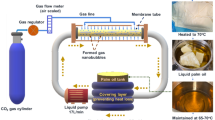Abstract
Duck eggs are one of the most versatile cooking ingredients in which residue eggshells are discarded. Raw duck eggshells were calcined at temperatures between 300 to 900 °C, for 1, 3, and 5 h. Both the raw and calcined duck eggshells were characterized by FTIR, STA, XRD, XRF, TEM, BET, a particle size analyzer, and an impedance analyzer. The proper calcination conditions are: 900 °C and 1 h, yielding calcium oxide with a purity of 99.06 % w/w. The calcium carbonate of the rhombohedral form (CaCO3) transforms completely into the calcium oxide or lime of the face centered cubic form (CaO) at 900 °C, as shown by XRD diffraction patterns. The transmission electron microscopy (TEM) images of the calcium oxide reveal a moderately good dispersion of nearly uniform particles. The calcium oxide has a white color, a spherical shape, high porosity, and narrow particles size distribution. The percentage of ceramic yield of the calcium oxide is 53.53, as measured by STA (TG-DTA-DTG). The calcium oxide has a N2 adsorption-desorption isotherm indicating the meso-porosity range. The dielectric constant and the electrical conductivity of the calcined calcium oxide are 35 and 1:0×10−6(Ω·m)−1, respectively, at the frequency of 500 Hz.
Similar content being viewed by others
References
Thapon J.L., Bourgeois C.M., Lavousier Technique at Documentation, L’Oeuf et les ovoproducts, 1994.
Rivera E.M. et al., Mater. Lett., 41 (1991), 128.
Adeyeye E.I., Bull. Chem. Soc. Ethiop., 23 (2009), 159.
Freire M.N., Holand J.N.F., Cerâmica, 52 (2006), 240.4.
Wan X. et al., Mater. Sci. Eng., 25 (2005), 455.
Meiszterics A., Sinko K., Colloids Surf. A: Physicochem. Eng., 319 (2008), 143.
Chrysafi R. et al., J. Eur. Ceram. Soc., 27 (2007), 1707.
Southam D.C. et al., Curr. Appl Phys., 4 (2004), 355.
Richardson I.G., Cem. Concr. Res., 38 (2008), 137.
Park H.J. et al., J. Environ. Sci., 19 (2007), 1436.
Jones D., ADAS Consulting Ltd. UK Utilization of egg shell waste from UK egg processing and hatchery establishments, Pigs, Eggs and Poultry Division, DEFRA, Whitehall Place East, London, 2002 (www.defra.gov.uk).
Murakami F.S., Rodrigues P.O., Cienc. Technol. Aliment., 27 (2007), 658.
Lu G.Q., Zhao X.S., Nanoporous Materials Science and Engineering, Imperial College Press, 4th editions, 2006.
Chen X.D. et al., Trans. I. ChemeE. part C, 77 (1999), 40.
Su B.L. et al., Microporous Mesoporous Mater., 105 (2007), 49.
Author information
Authors and Affiliations
Corresponding author
About this article
Cite this article
Tangboriboon, N., Kunanuruksapong, R. & Sirivat, A. Preparation and properties of calcium oxide from eggshells via calcination. Mater Sci-Pol 30, 313–322 (2012). https://doi.org/10.2478/s13536-012-0055-7
Received:
Accepted:
Published:
Issue Date:
DOI: https://doi.org/10.2478/s13536-012-0055-7




